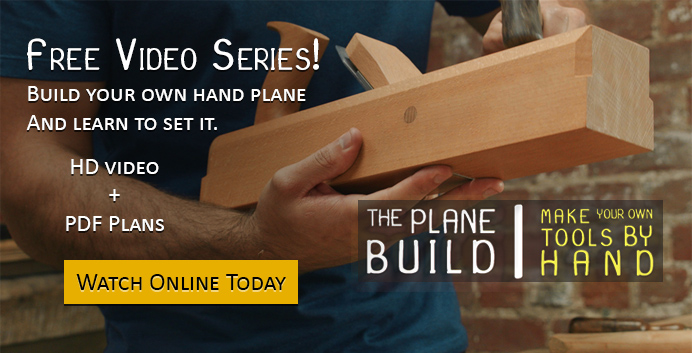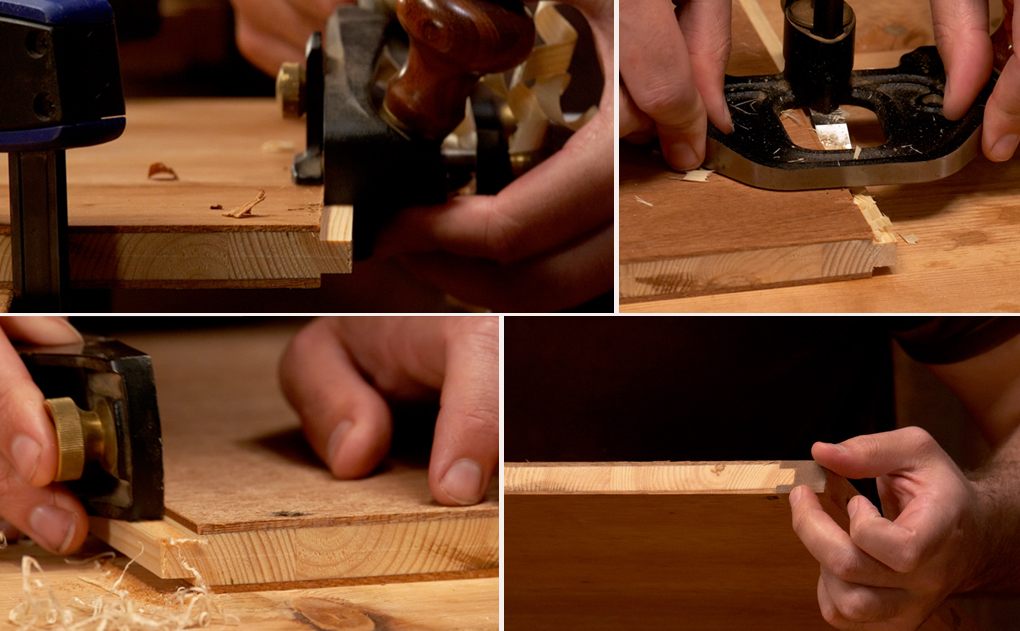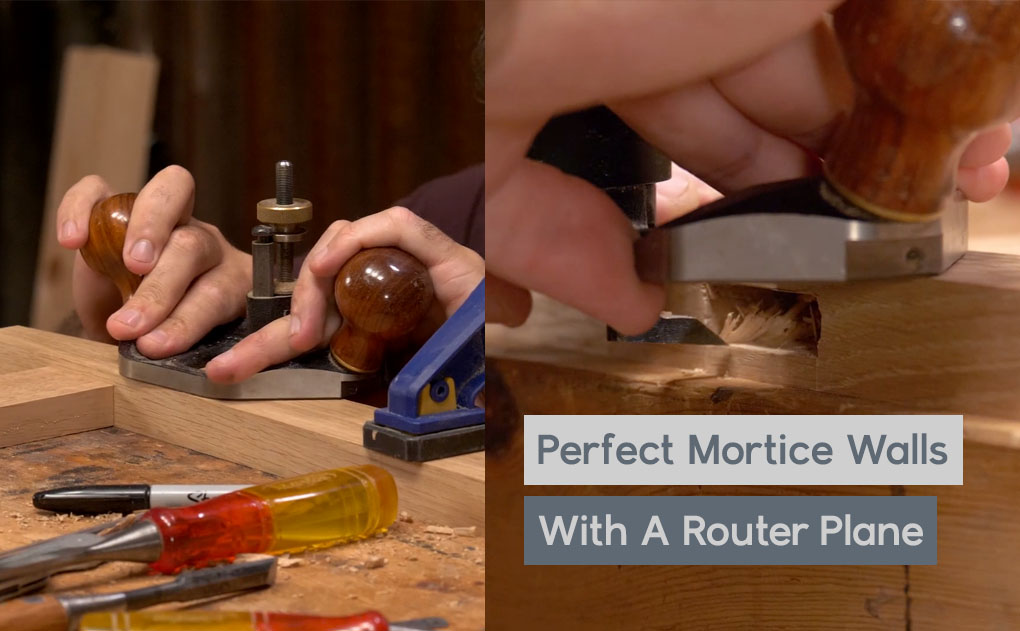
When edge jointing boards for gluing up a wide panel or top, I’ll check the joint by offering up a straight edge.
Many of you have pointed out my shoddy array of straight-ish, straight edges.
I’m often asked if there’s a reason why I favour these home made things over something more posh.
This is one of those questions where I really wish I had a good answer. I don’t, but I’ll still cobble one together anyway.

Super precision isn’t required in your straight edge when you’re looking for high spots in a rough sawn panel.
First off, they don’t have to be fancy –
It’s easy enough to make one accurately straight off a hand plane. I can certainly see a point to the highly priced things that you can buy, those that even come with a certificate of straightness. But that’s not at all needed for what I do… maybe more for engineering uses?

As you approach flat you’ll want to check the surface thoroughly across it’s width, length and diagonals. Even for this small table it was nice to have good long straight edge. If you’re keen to work by hand then we always recommend spending less time worrying about the precision of your tools and more time learning efficient techniques. The full process of efficiently preparing, gluing & flattening this top is shown in detail in our ‘Build A Hall Table’ series – which you can watch online (details here)
The second reason is that I like wood.
Metal is always going to scratch my work and I hate the feel of it.
This third point definitely has the most clout to it.
You never know if you’re going to need a different length of stick.
If you’re buying a straight edge, then you’re picking from fixed sizes – often 2ft.
If you imagine needing to check the diagonal of a crooked table top, much like in our coffee table video, that 2ft leaves you short. It’s nice here to just grab a bit of gash that’s plenty long enough and plane it straight.
And I suppose that sums it up. If it’s that easy to make one, why bother with owt posh?

Twist or winding sticks can also be made easily out of a bit of gash. Here you’ll need to take extra steps to get a matched pair but you can still get that accuracy straight off a hand plane.
If you’d like to learn more about what’s essential and what’s not when working by hand, then have a read of this post, where we guide you through our recommendations for a getting started tool kit.
Or get in some practice while you have a go a building your own wooden hand plane. Follow step-by-step in our free build video (includes PDF plans).


![Which Saws Are Best For Ripping Thick Stuff? [Video]](https://www.theenglishwoodworker.com/wp-content/uploads/2022/12/what-hand-saw-is-best-for-thick-rip-cuts.jpg)

![Quick Homemade Clamps – Small & Large [with video]](https://www.theenglishwoodworker.com/wp-content/uploads/2022/08/how-to-make-your-own-woodworking-clamps.jpg)

Richard, your points just make “plane, straight-up sense”.
(I’ve spelled plain wrong intentionally).
If I can’t plane a 3 or 4 or 5-foot skinny length of timber until it’s good enough for me to use it as a good straight edge, then, there is little hope of me being able to flatten a tabletop or a bench or something similar even with a fancy metal straight edge.
Keep ‘er lit Bro!
I can see the utility of a custom size straight edge for large projects. However you might need to make three of them to be sure they’re straight.
Two edges might match if one is a mirror of the other but three edges which match each other must be straight.
One can do judge straightness quite well with two edges, even of different lengths, by using only half of the length of one. And of course there is sighting down the length.
Sensible, real world advice as always!
I think the rule of thumb is you can trust your plane to flatten a piece of wood three times its own length, so a no 6 will give you a close to perfect 4’6″ straight edge.
The only thing I’ve found in my workshop where the humidity and temperature goes up and down like a jack in the box is that my straight edges and winding sticks don’t stay wonderfully straight, but it’s the work of a minute to straighten them again before use – they just get a bit thinner over time 😮
The way I learned to make straight edges is to always make two.
* Clamp two sticks side-by-side and plane the top face as straight as you can.
* Un-clamp, flip one over and mate the planed faces. Look for high spots, which will be touching.
* Flip back over, re-clamp, and plane the high spots.
* Repeat and stop when you’ve met your own standards.
The beauty is that by using the same plane to alter both sides of a mirror image at once, you insure against fooling yourself into a false sense of straightness.
Good to hear from you as always Richard. I just rewatched the workbench build series and I was wondering about this very thing after seeing you use nothing more than a couple of sticks.
I’m slowly learning that the idea of perfectly straight is not a real-world concept. The most over used word in internet woodworking videos is perfect, I reckon.
This makes sense to me . I get the impression that real woodworkers do not need 1/2 as many tools as they start out thinking they do . Sound advice richard.
Another factor to consider on making an edge super straight is the cutter engagement. Even an #7 can plane a curve with a heavy cut set. Making wispy shavings will maximize the precision of the work.
Too right. I have a pair of winding blocks, I say blocks because they’re lashed together out of 2×4’s I had sitting around. I only knew how to do it because of Richard – before I thought making winding sticks would take a huge amount of precision and time/skill that I didn’t possess. They work well enough for my needs. Sometimes there’s just to much over thinking and complication on things that in reality are actually very straight forward when you have a go at it.
I look forward to the day I have the skills and confidence to sell my crutches.
Well at least it’s not a Zimmer frame.
The only way I was ever really taught how to find out if a piece of wood was straight, was to close one eye and have a butchers (look) down it ! It’s a bit like if you were to do the same as looking down a washing line at home , even though the washing line would slightly sag in the middle down over ,it would be straight on its side along its length , if that makes sense .
It’s was a great thing to learn as you could use it everywhere from looking down a 5m 9×2
Ceiling joist to see were the camber in the joist was and put that to the top when setting out so over time it would straighten out , well that was the plan anyway.
Winding door frames in so they met almost perfect , the same as using two winding sticks on a table top to bring both ends in plane with each other, so easy and effective and no tools required apart from looking like a snooker referee bobbing up and down and side to side with one eye shut pulling a funny face 😉😂 haha!
The problem is now I think that method might be getting lost with a lot of others
As when I was using them methods the insides of houses were built using pine
And I always had a dedicated straight edge pulled out from a pile of 3×2 cut down to about 6ft as long as it had one straight ish
edge that would do the job !
I honestly believe that’s why people feel more at home living in an old built house,
It’s those slight imperfections that give that home it’s own character , like it’s one of kind . Unlike today’s modern built houses
with your perfectly steel stud straight walls
And your laser levelled floors must feel like living in a painted metal box .
So after all that I suppose that’s why I like to use a bit old of gash planed flat on one edge , but then looking down it for straightness not trusting the plane to do it for me or if I want a longer one just put me chalk line on twang it and plane to that .
So I suppose what I like about a wood straight edge is its slight imperfections which in turn will be in my finished work piece , I’m not saying it will be built a bit rough , more it will be unique to me and everyone else . I think that’s what makes
Hand built furniture amazing you cant help yourself if you go past a piece in an old hall or house to want to sit in it or just run your hand over it or see how it’s built , it just gives you a good feeling , like the old houses I was talking about , for me it’s the imperfections that make them feel perfect!
Nice post.
Thanks Duncan
A sometimes think a rattle on a bit though cheers 👍
I wish I could be this confident. I am not sure any edge I plane is straight. I could use my planer, however the wood bends within hours anyway. Normally it will be 0.5cm out at the middle within a week. Having to re-plane, or make new ones every week is simply not worth it compared to the (admittedly costly) £50 for a 1m straight edge.
If I do have large projects I use the 2m level, which is “good enough”.
I can’t quite understand how you can use wood when it bends. I was always taught to join as soon as you’ve finished shaping, to hold the pieces straight, and have seen the effect when leaving out a dovetail drawer unassembled, came back the next week, and it was ruined due to curving.
BTW: humidity here is about 20% right now, and goes up/down in the year, but not over a period of days, and the wood is always kiln dried and well acclimatised.